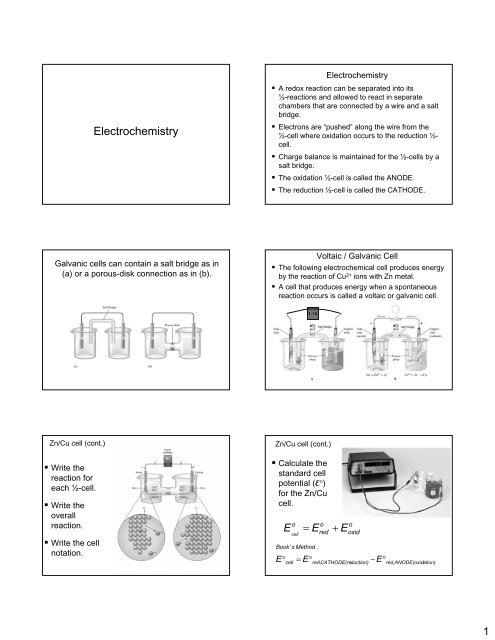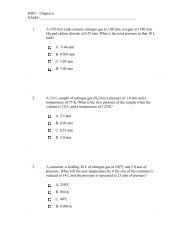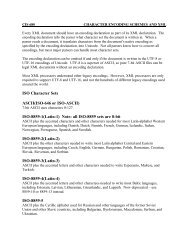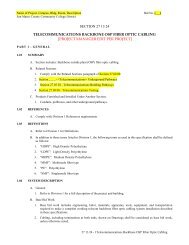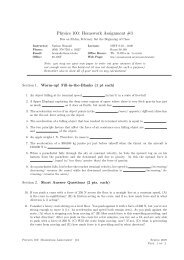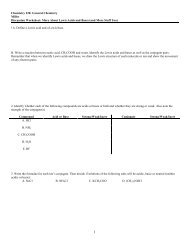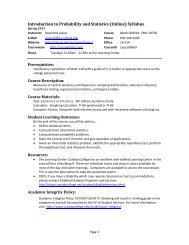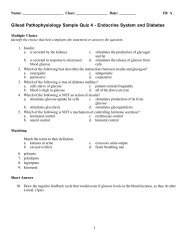Electrochemistry
Electrochemistry
Electrochemistry
Create successful ePaper yourself
Turn your PDF publications into a flip-book with our unique Google optimized e-Paper software.
<strong>Electrochemistry</strong><br />
<strong>Electrochemistry</strong><br />
• A redox reaction can be separated into its<br />
½-reactions and allowed to react in separate<br />
chambers that are connected by a wire and a salt<br />
bridge.<br />
• Electrons are “pushed” along the wire from the<br />
½-cell where oxidation occurs to the reduction ½-½<br />
cell.<br />
• Charge balance is maintained for the ½-cells ½<br />
by a<br />
salt bridge.<br />
• The oxidation ½-cell ½<br />
is called the ANODE.<br />
• The reduction ½-cell ½<br />
is called the CATHODE.<br />
Galvanic cells can contain a salt bridge as in<br />
(a) or a porous-disk connection as in (b).<br />
Voltaic / Galvanic Cell<br />
• The following electrochemical cell produces energy<br />
by the reaction of Cu 2+ ions with Zn metal.<br />
• A cell that produces energy when a spontaneous<br />
reaction occurs is called a voltaic or galvanic cell.<br />
1.10<br />
Zn/Cu cell (cont.)<br />
• Write the<br />
reaction for<br />
each ½-cell. ½<br />
• Write the<br />
overall<br />
reaction.<br />
• Write the cell<br />
notation.<br />
Zn/Cu cell (cont.)<br />
• Calculate the<br />
standard cell<br />
potential (E°)(<br />
for the Zn/Cu<br />
cell.<br />
Book' s Method :<br />
E°<br />
o o<br />
E<br />
cell<br />
= Ered<br />
+<br />
cell<br />
= E°<br />
E<br />
o<br />
oxid<br />
red,CATHODE(reduction)<br />
−E°<br />
red,ANODE(oxidation)<br />
1
Electrical Potential<br />
• Electromotive force (emf(<br />
emf) ) is the driving or pushing of<br />
electrons from the anode to the cathode.<br />
• Electrons always flow from the electrode with the lower<br />
reduction potential to the electrode with the higher reduction<br />
potential.<br />
• Cell potential (E°)(<br />
) is related to electrical work (Joules) as<br />
charge (coulombs) flows in a circuit:<br />
Volt (V) = Joule (J) / coulomb (C)<br />
• A coulomb is the amount of charge that passes a single<br />
point in an electrical circuit when one ampere of current<br />
flows for 1 second.<br />
1 Coulomb = 1 Ampere • second<br />
1 Coulomb = charge of 6.24 x 10 18 electrons<br />
charge of 1 electron = 1.602 x 10 -19<br />
C<br />
Electrical Potential<br />
• Galvanic cells must always have a positive cell<br />
potential.<br />
• Which of the following redox pairs will function at<br />
the ANODE in each of the following pairs? Also<br />
calculate the cell potential.<br />
• Cd 2+ / Cd<br />
and Sn 4+ / Sn 2+<br />
• Zn 2+ / Zn and Al 3+ / Al<br />
• Br 2 / Br - and MnO 4- / Mn 2+<br />
• Standard potentials are<br />
measured for Standard<br />
Thermodynamic conditions:<br />
T = 298 K<br />
[X] = 1 M P X = 1 atm<br />
• All standard reduction<br />
potentials are measured<br />
relative to the Standard<br />
Hydrogen Electrode (SHE).<br />
• SHE is composed of a<br />
solution that is 1.0 M H + and<br />
an enclosed atmosphere with<br />
P H2 = 1.0 atm<br />
• SHE is assigned a standard<br />
reduction potential of zero.<br />
Standard Potentials<br />
Figure a: A galvanic cell involving the reactions:<br />
Zn Zn 2+ + 2e - (oxidation - at the anode)<br />
2 H + + 2 e - H 2 (reduction - at the cathode)<br />
and has a potential of 0.76 V.<br />
What is the reduction potential for Zinc?<br />
Electrochemical Cell with Cu and SHE<br />
Relative Oxidizing and Reducing Power<br />
• Cu has a standard reduction potential of<br />
+ 0.34 V.<br />
• Will copper be oxidized or reduced in a cell<br />
with SHE?<br />
• Diagram a standard cell that could be used to<br />
find the standard reduction potential of<br />
copper. Use SHE as one electrode in the<br />
cell.<br />
2
Relative Oxidizing and Reducing Power<br />
• Which of the following is most easily oxidized?<br />
Al<br />
Sn<br />
Cd<br />
• Which of the following is most easily reduced?<br />
Mg 2+ Na + V 3+<br />
• Which of the following is the best reducing agent?<br />
Zn<br />
Zn 2+ V 2+<br />
• Which of the following is the best oxidizing agent?<br />
H + Ni 2+ Fe 2+<br />
Relative Oxidizing and Reducing Power<br />
• Which of the following can reduce Al 3+ ?<br />
K or<br />
Fe<br />
• Which of the following can oxidize Al?<br />
Mg 2+ or<br />
Zn 2+<br />
• Which of the following can reduce H + ?<br />
F –<br />
or<br />
Ni<br />
• Which of the following can oxidize H 2 ?<br />
Sn 4+ or<br />
Zn 2+<br />
Relationship of Free Energy and Cell Potential<br />
• The free energy change for a reaction relares to the maximum<br />
amount of work that can be done by a chemical system:<br />
∆G = w max<br />
• Electrical work is related to cell potential and the number of<br />
electrons transferred in a chemical process:<br />
w = −nFE<br />
max<br />
• Combining these two equations, we can relate free energy change<br />
and cell potential:<br />
∆G = −nFE<br />
Where n = # electrons transferred (as determined from the balanced<br />
reaction), and F = Faraday constant:<br />
F =<br />
J<br />
C<br />
= 96,485<br />
V • mol( electron)<br />
96, 485<br />
mol(<br />
electron)<br />
Standard Free energy and Cell Potential<br />
• Under standard thermodynamic conditions:<br />
∆G°<br />
= −nFE<br />
°<br />
Standard Cell Potentials & K<br />
RT<br />
E°<br />
= lnK<br />
nF<br />
0.0257<br />
E°<br />
= lnK<br />
n<br />
Standard and Non-Standard Cell Potentials<br />
o o<br />
E<br />
cell<br />
= Ered<br />
+<br />
cell<br />
red<br />
E<br />
E = E + E<br />
Book' s Method :<br />
o<br />
oxid<br />
oxid<br />
E<br />
cell<br />
= Ered,<br />
CATHODE<br />
− Ered,<br />
ANODE<br />
Nernst Equation<br />
• Under non-standard conditions of pressure or<br />
concentration (at 298 K):<br />
RT<br />
E = E° − lnQ<br />
nF<br />
• Because R,T, and F are all constant<br />
(T=298<br />
K), we often use the following form of the<br />
Nernst equation:<br />
0.0257<br />
E = E°<br />
− lnQ<br />
n<br />
3
Electrochemical Cell Diagrams<br />
Diagram a functional voltaic cell with the following<br />
couple under standard conditions:<br />
{Fe +2 / Fe} {OCl<br />
− (aq) / Cl − (aq) (in basic solution)}<br />
Be sure to include all of the following in the<br />
diagram:<br />
• Label cathode and anode<br />
• Appropriate metal electrodes<br />
• Concentrations of important SPECIES in each cell.<br />
• BALANCED half reaction occurring in each cell.<br />
• All components required to have an operating circuit.<br />
Fe 2+ / OCl -<br />
Cell diagram (cont.)<br />
‣ Write the balanced overall reaction for the cell.<br />
‣ Calculate E° for the cell.<br />
‣ Calculate ∆G° for the reaction.<br />
‣ Calculate K for the reaction.<br />
‣ Calculate E cell (at 298 K) if:<br />
[Fe 2+ ] = 0.10 M<br />
[OCl<br />
– ] = 0.25 M<br />
[Cl<br />
– ] = 0.50 M<br />
pH = 12.00<br />
Electrochemical Cell Diagram<br />
Diagram a functional voltaic cell with the following<br />
couple under standard conditions:<br />
{Cu +2 / Cu} {MnO − 4 (aq) / Mn 2+ (aq) (in acidic solution)}<br />
Be sure to include all of the following in the<br />
diagram:<br />
• Label cathode and anode<br />
• Appropriate metal electrodes<br />
• Concentrations of important SPECIES in each cell.<br />
• BALANCED half reaction occurring in each cell.<br />
• All components required to have an operating circuit.<br />
Cu 2+ / MnO - 4 Cell diagram (continued)<br />
‣ Write the balanced overall reaction for the cell.<br />
‣ Calculate E° for the cell.<br />
‣ Calculate ∆G° for the reaction.<br />
‣ Calculate K for the reaction.<br />
‣ Calculate E cell (at 298 K) if:<br />
[Cu ] = 2.0 M<br />
[MnO 4–<br />
] = 0.10 M<br />
[Mn ] = 0.50 M<br />
[H + ] = 1.0 M<br />
The Nernst Equation<br />
and non-standard half-cells<br />
• Calculate the E red for a Ni 2+ /Ni (s) ½-cell when<br />
[Ni 2+ ] = 0.001 M.<br />
Concentration Cells<br />
• Calculate the E red for a Ni 2+ /Ni (s) ½-cell when<br />
[Ni 2+ ] = 5.0 M.<br />
• Calculate the E oxid for a Sn 4+ / Sn 2+ ½-cell<br />
when [Sn 4+ ] = 0.50 M & [Sn 2+ ] = 0.00025 M.<br />
4
Equilibrium Constant & Cell potentials<br />
• Based on cell potentials, calculate K for the<br />
following reactions at 25˚C:<br />
Equilibrium Constant & Cell potentials<br />
• Based on cell potentials for the following<br />
½-reactions, calculate the K sp value for AgBr<br />
at 25˚C.<br />
• Compare this to the listed value in the book.<br />
Electrolysis<br />
• Electrolysis is the use of an applied electrical<br />
current to bring about chemical change.<br />
• A voltaic (or galvanic) cell produces electrical<br />
energy as a spontaneous reaction occurs.<br />
Galvanic and Electrolytic Cell Comparison<br />
Figure (A): A standard galvanic cell based on the<br />
spontaneous reaction<br />
Figure (B): A standard electrolytic cell. A power source<br />
forces the opposite reaction<br />
A. B.<br />
• An electrolytic cell uses electrical energy to<br />
drive the non-spontaneous chemical process.<br />
Anode<br />
Cathode<br />
Cathode<br />
Anode<br />
Formation of CuBr 2<br />
• Elemental bromine reacts with metal copper<br />
in a highly product favored reaction:<br />
Electrolysis of CuBr 2<br />
• CuBr 2 does not spontaneously decompose to Cu<br />
and Br 2(l) . Consider the reaction:<br />
Cu (s)<br />
• Based on the ½-cell ½<br />
potentials, estimate a<br />
value of K for this reaction.<br />
• If we wish to drive this reaction, we must change the<br />
conditions to make this process favorable.<br />
• We can apply an external voltage from a power<br />
source.<br />
• The voltage we apply must be greater in magnitude<br />
than the cell potential for the spontaneous reaction,<br />
and applied in the reverse polarity.<br />
5
Electrolysis of CuBr 2 (continued)<br />
• What minimum voltage must be applied to<br />
electrolyze copper (II) bromide?<br />
• Consider a diagram of the electrolytic cell:<br />
Electrolysis of H 2 O<br />
• Consider the electrolysis of water under<br />
neutral conditions with a strong electrolyte<br />
like KCl in solution (to increase the<br />
conductivity of the water). View quicktime<br />
quicktime movie.<br />
• Note that the electrolytic cell need not be separated<br />
into individual compartments.<br />
• Diagram the electrolytic cell.<br />
• Write both ½-reactions.<br />
½<br />
• Determine the minimum potential needed to<br />
electrolyze the water.<br />
Electrolysis of H 2 O (continued)<br />
• If we try to electrolyze other compounds in<br />
water, we must consider whether the<br />
electrolysis of water or of the ion in solution is<br />
more favorable at that electrode.<br />
Electrolysis of KBr<br />
• To determine if KBr can be electrolyzed to K (s) and Br 2(l) in<br />
aqueous solution, we must consider all potential reactions at<br />
the cathode and anode.<br />
• CATHODE:<br />
Electrolysis of KBr (continued)<br />
• Based on the cathode and anode reactions<br />
that are most favorable, write the overall<br />
reactions for the electrolysis of a KBr solution.<br />
• ANODE:<br />
• Calculate the minimum applied voltage to<br />
drive this reaction.<br />
6
Electrolysis of KBr (continued)<br />
• In order to separate KBr into its elements,<br />
molten KBr must be electrolyzed. Because of<br />
the high temperature required, special<br />
equipment is needed.<br />
• Consider a diagram of the electrolysis of<br />
molten KBr:<br />
• Estimate the minimum applied voltage to<br />
drive the reaction.<br />
Electrolysis & Current<br />
• Electrolytic processes are important in the<br />
production of a number of important industrial<br />
chemicals: aluminum metal, copper metal, chlorine<br />
gas, sodium hydroxide, and many others.<br />
• To determine the mass that is formed when an<br />
electrolytic process takes place, we must know the<br />
current applied and the time it is applied.<br />
• Current (ampere) is the flow of charge.<br />
1 ampere (A) = 1 coulomb (C) / second (s)<br />
Electrolysis and counting electrons<br />
• What mass of zinc can<br />
be plated by the<br />
application of 10.0 A<br />
for 30 minutes?<br />
Electrolysis and counting electrons<br />
• What time is required<br />
to plate 500 mg of<br />
gold onto a ring by<br />
applying a current of<br />
5.0 A to a solution of<br />
AuCl 3 ?<br />
A schematic diagram of an<br />
electrolytic cell for producing<br />
aluminum by the Hall-Heroult<br />
process.<br />
Aluminum is produced commercially by the process<br />
illustrated above. What current must be applied to<br />
produce 1000. kg of aluminum in 2.0 hours?<br />
7


